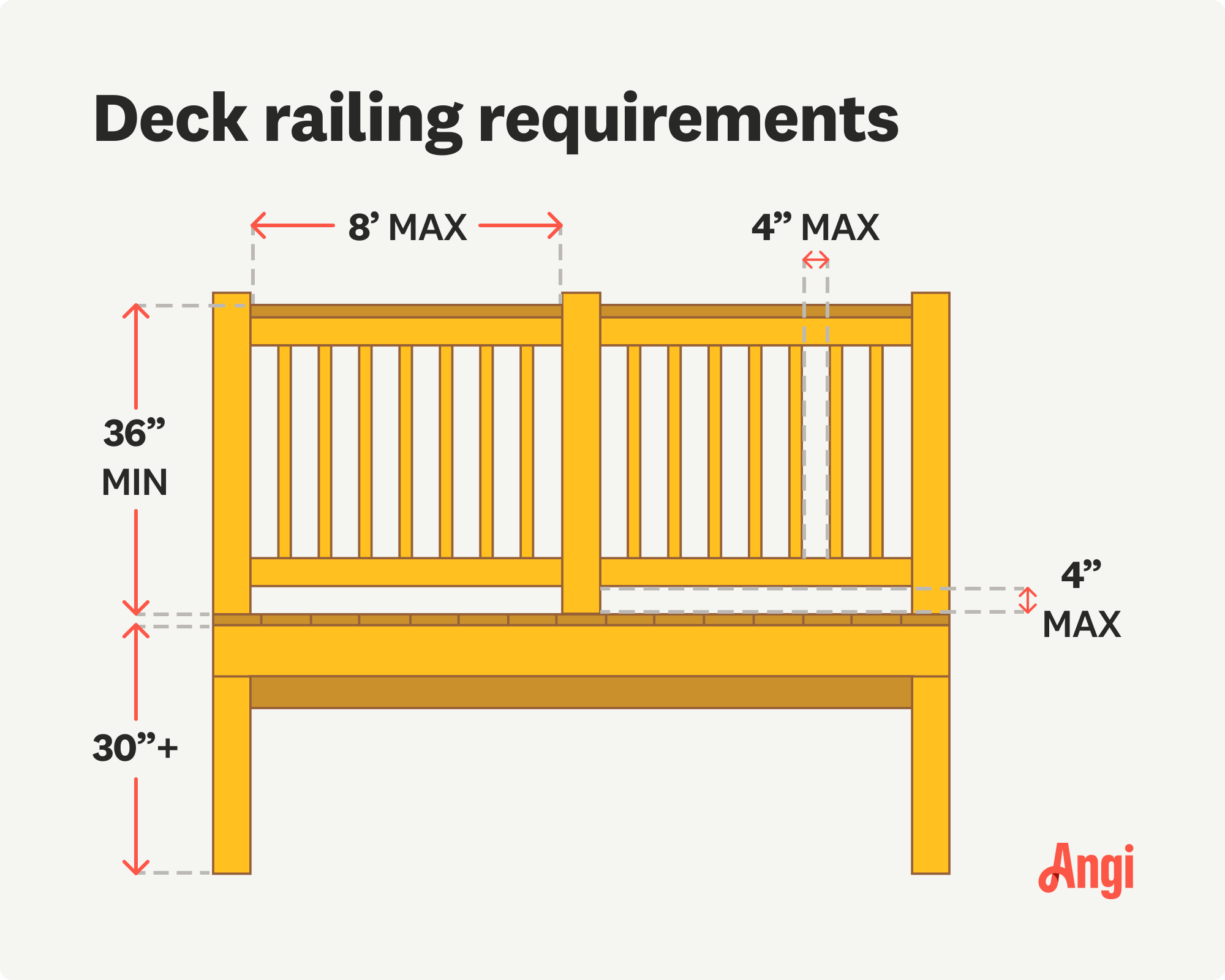
If you’re updating a deck or staircase with a modern railing, you may be wondering how much cable railing costs. We dive into the cost factors you need to know.
Installing a deck railing ranges from $400 to $4,800, depending on the size, style, materials, and labor. A pro will walk you through these estimates and more before construction begins.


Decks and porches with complex angles and corners typically demand higher-than-average rates.
Installing rails on a freshly built deck is generally cheaper than replacing rails on an existing deck.
The average labor cost to install a deck railing is $30 per linear foot.
After size, material type is the largest factor influencing deck railing cost.
On average, homeowners pay $2,500 when building a deck railing. Contractors estimate the cost of this project based on the railing’s linear footage, but many other details go into the final budget, including the materials you choose, where you live, and the condition of the existing deck railing. We’ll break down all the cost factors below.

Let’s take a look at the cost factors to consider when budgeting for this project.
The linear footage of the railed portion of your deck is the biggest factor in determining the deck railing cost for labor. You can expect to pay more for larger decks and porches. Determining the linear footage needed for your deck railing requires firsthand measurements, as the size varies based on the deck’s layout.
Below, we’ve listed the linear footage of several common deck sizes and calculated the average railing cost for the whole space. It costs between $10 and $50 per linear foot on average. Most railings need posts at least every six feet for support, while some metal and composite railings can have posts every eight feet.
| Deck Dimensions | Linear Feet | Average Railing Cost |
|---|---|---|
| 10 x 10 | 40 | $400–$2,000 |
| 12 x 12 | 48 | $480–$2,400 |
| 12 x 16 | 56 | $560–$2,800 |
| 16 x 16 | 64 | $640–$3,200 |
| 16 x 20 | 72 | $720–$3,600 |
| 20 x 20 | 80 | $800–$4,000 |
| 20 x 24 | 96 | $960–$4,800 |
One of the biggest cost factors is your deck railing’s material. An inexpensive material like wood or Trex should keep the budget low, while pricier materials like steel and glass can quickly add up. Materials range in price depending on quality and location.
Aluminum and stainless steel cost an average of $40 to $80 per linear foot, and composite is the budget option, starting at $15 per linear foot.
| Material | Cost per Linear Foot |
|---|---|
| Wood | $15–$50 |
| Composite / Trex | $15–$60 |
| Vinyl / PVC | $20–$60 |
| Wrought Iron | $50–$100 |
| Aluminum | $50–$200 |
| Steel | $50–$250 |
| Cable | $60–$500 |
| Glass | $100–$600 |
Most contractors charge per linear foot for deck rail installation labor, ranging from $10 to $50 per linear foot. On average, the labor price is $30 per linear foot. Some contractors prefer to charge for deck railing installation by the hour instead of charging by linear foot. The average labor cost to replace deck and porch railings is $50 to $150 per hour, depending on the type of contractor.
Railing contractors may charge more for labor for replacing rails on a hard-to-access deck or porch. For instance, a "balcony" deck requiring a contractor to work on a high, cramped space could bring in a higher estimate than a deck situated on a flat, large yard with plenty of room for tools and equipment.
In addition to your deck’s location, your home’s location also plays a factor in pricing. If you live in an area with a high cost of living, like New York City or San Francisco, you can expect to pay higher labor costs than an area with a more affordable cost of living.
The existing deck setup helps to determine how much a new railing installation will cost. Here's a look at some factors that can impact cost.
If you're planning to tear off existing rails to add new rails to a bare-faced deck, this decision generally makes a railing swap less expensive. Expect to pay between $10 and $15 per linear foot for this scenario. In addition, sticking with standard factory-length railings will also keep pricing in that same price range per linear foot. In these scenarios, the railing pro will be able to tear off nailed-in railing from the wood to install new factory-length rails.
If you're planning to fit new rails between existing support posts, that could increase labor costs due to the customization and detail required. Contractors could charge as much as $25 to $30 per linear foot to accommodate for the necessary cuts. Expect to pay on the higher end of that range if your deck has lots of angles and corners. If you can fit new rails between existing posts that are in good shape, the cost might be closer to $20 per linear foot.
The cost range might also be closer to $20 per linear foot if your posts fit a factory-available vinyl railing length. Considering that the cost of vinyl railing is $20 to $40 per linear foot, it's possible for a deck or porch with existing posts that need to be worked into the job to still be updated on a budget. The cost savings from fitting new railings between existing posts might be eaten up just a little when choosing metal deck railings instead. The cost of metal deck railing ranges from $40 to $70 per linear foot.
If any existing posts need to be replaced due to rot, damage, or style preferences, the cost per new post ranges from $20 to $120. Your railing contractor should inspect your existing posts to determine whether they need replacing before diving into the project.
One of the easiest ways to save money when installing a new deck railing is to do the job yourself. The DIY route eliminates the cost of labor, meaning you only have to pay for the tools and materials, which lowers the budget by hundreds of dollars. Materials required to complete a 100-foot section of a porch or deck range from $150 to $6,000, depending on the type and quality.
However, deck railing installation requires accurate cuts on various railing materials, which can be difficult and dangerous without experience. We recommend hiring a handrail expert in your area for the job. In addition to creating a sturdy design and appealing look, they will ensure that your new railings comply with local codes, eliminating liability risk from unsafe DIY railings.
Home is the most important place on earth, which is why Angi has helped more than 150 million homeowners transform their houses into homes they adore. To help homeowners with their next project, Angi provides readers with the most accurate cost data and upholds strict editorial standards. We extensively research project costs to develop the pricing data you see, so you can make the best decisions for you and your home. We rely on reputable sources, including the U.S. Bureau of Labor Statistics, academic journals, market studies, and interviews with industry experts—all to ensure our prices reflect real-world projects.
Want to help us improve our cost data? Send us a recent project quote to [email protected]. Quotes and personal information will not be shared publicly.
From average costs to expert advice, get all the answers you need to get your job done.

If you’re updating a deck or staircase with a modern railing, you may be wondering how much cable railing costs. We dive into the cost factors you need to know.

Trex decking can offer your home a beautiful, durable outdoor oasis. Learn all about the costs of Trex decking based on space, size, and style.

Trying to calculate your pool deck cost? Our guide walks you through both inground and above-ground pool deck cost factors, such as material, location, and labor rates.

Still deciding between a terrace or a balcony for your home? Learn the pros, cons, and key differences to pick the perfect fit for your space.

Nothing ruins outdoor ambiance like a greenish deck. Discover why your deck turns green and find some straightforward solutions to fix and prevent the issue.

Many homeowners wonder, "Why are my deck boards warping?" Here are the most common causes, solutions, and the best steps for prevention.